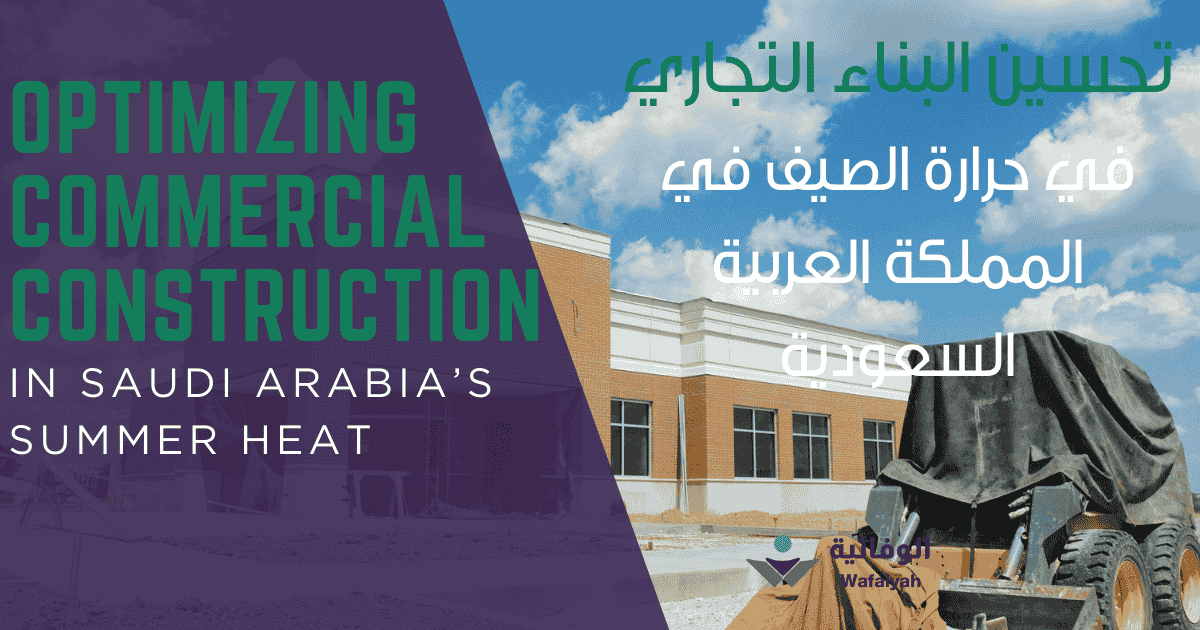Saudi Arabia’s intense summer heat, often exceeding 50°C, can negatively affect commercial capital projects because of the potential for delays, lower productivity, and material quality issues (e.g., concrete and asphalt). Construction materials exposed to hot temperatures can dry faster, and fast drying can impact concrete structural integrity and introduce potential safety risks for workers when temperatures exceed. So, construction companies should deploy heat management strategies to prevent impacts on project schedules and project quality.
The intensity of the summer heat in Saudi Arabia has real construction risks for commercial capital projects. Workers can face serious safety risks, including increased risks of heat-related illness (e.g., heatstroke or dehydration), injury, and death, especially with prolonged exposure to extreme summer heat. Worker productivity can also be reduced because of safety concerns and working conditions. Material performance can also be affected; for example, concrete that is exposed to extreme summer heat can set too quickly, meaning some structural integrity may be compromised if it is not controlled. Also, overheating equipment or cooler energy demands will take more time and incur material costs to finish the project on budget.
Strict infrastructures and construction regulations require companies to reasonably interpret regulations to mitigate heat stress, some of which include prohibiting work during the hottest part of the day, providing shaded rest areas, and providing water & cooling systems at all times when workers are present. Also, determining whether to alter construction schedules, use materials that are less affected by heat (e.g., stone or mortar systems), or reasonable use of cooling technologies. Managing the intensity of the available heat is critical for all involved in the construction process to preserve construction quality, protect laborers’ health, and ensure project completion timelines are achieved despite Saudi Arabia’s extreme climate in the summer months.
Extreme Heat and Construction Materials
In Saudi Arabia, extreme heat can seriously affect the quality and performance of construction materials. Extreme temperatures can cause the rapid setting of concrete, resulting in weaker structures with the potential for cracking later on. Asphalt used in pavement can soften excessively, leading to deformation that may involve costly repairs. Steel structures will expand in heat and may subsequently misalign and stress joints. Coatings, sealants, and paints will cure improperly or lose protective qualities.
Mitigating these risks requires careful consideration during planning stages, such as utilizing additives in concrete, conducting work at cooler times of day, and providing cover and protection from exposure to the sun. Failure to make appropriate allowances for these extreme summer conditions can lead to compromised workmanship and durability and safety issues within commercial buildings and infrastructure projects as the project progresses.
Workforce Productivity and Safety Challenges
Workforces in Saudi Arabia’s extreme summer temperature present a remarkable challenge for productivity and safety. The risk of heat exhaustion, dehydration, and even life-threatening heat stroke increases after prolonged exposure to extreme heat. When laborers are monitored for their safety in extreme summer temperatures, they must be afforded more frequent breaks from work, and the work schedule may even need to shift to accommodate work during cooler morning or evening hours to reduce potential heat exposure.
We have to ensure there are regulations around rest breaks, hydration stations, and areas with shade provided to mitigate our responsibility to the employee workforce. Still, even all of these provisions will lead to lower productivity overall during the hottest months. The immediate focus is on protecting the workers’ health; without this focus, there may be legal repercussions, project slowdowns, and added expenses related to lost labor time from medical emergencies.
Construction Delay Due to High Temperature
In Saudi Arabia, high summer temperatures can create significant delays in commercial construction projects. Extreme heat often requires that companies adjust work schedules for heat, which usually leads to less workable hours in the day. Heat will lead to additional issues on site (overheated equipment, slower curing time for processed materials, and enforced work stoppages in the middle of the day), all of which, even if understood, will delay construction progress.
All construction work will halt during heatwaves, resulting in significant project delays and expenses. A delay in the project affects the delivery of a project, client relationships, and future work for a company. Given the effects of high temperatures on work progress, it is evident that the solution for companies is to think about heat management strategies such as implementing rapid curing materials where applicable, scheduling important tasks for cooler times of the day, etc., can help maintain project progress in less than ideal weather.
Heat management is essential for construction sites, whether for worker safety and productivity, equipment safety and longevity, or project advancement. One of the best engineering solutions available today is putting in place various cooling systems on a construction site, including fans (misting), evaporative coolers, and portable air-conditioners (sitting them in convenient locations). It includes more modern innovations in the use of reflective and heat-resistant materials for scaffolding and temporary structures that would assist in reducing ambient temperatures. Other emerging advantages include the use of clever wearable technology that provides the workers’ core temperature and hydration levels so you can see the metrics before someone reaches the critical point for a heat-related illness.
An additional technique that works well is planning site layouts to take full advantage of natural ventilation and shade. Engineers are now using modular canopy structures, temporary vegetation walls, and heat-reducing pavement paint to promote cooler indoor conditions. Scheduling physically demanding tasks very early or late in the evening due to the cooler temperatures is an example of a simple yet powerful tactic. Sophisticated weather stations used in combination with construction management software allow teams to schedule work during cooler periods. All these solutions improve safety by reducing heat risks while improving the overall productivity of construction work.
Regulatory Compliance and Standards for Summer Construction
During summer, construction activities in Saudi Arabia are stringently monitored through legal compliance to protect workers from extreme heat. The “No Work Under the Sun” rule, set by the Ministry of Human Resources and Social Development, bans outdoor work between the hours of twelve and three from June 15 to September 15 every year. During this period, employers must modify work schedules, provide shaded rest areas, provide medical supervision, and monitor water access. Adherence to these requirements is strict and subject to regular audits and heavy fines for noncompliance.
Sustainable Building Practices for Hot Saudi Climate
Sustainable building practices for hot climates look at how to avoid the excessive intake of heat and energy consumption, maximizing natural ventilation, and minimizing energy consumption. Each building requires designed high-reflectivity roofing materials, insulated wall systems, and ventilated façades to prevent excessive indoor heating. Architects strategically orient the structures to limit direct exposure to sunlight, which involves recipes of shade such as shaded courtyards. These buildings are also constructed using thermal mass stone and concrete materials that help regulate temperature fluctuations. Another form of temperature control is the use of green roofs and vertical gardens, which greatly improve the natural cooling of the structure and air quality.
Moreover, passive cooling methods forming the core of sustainable designs include cross-ventilation, stack ventilation, and earth-cooling tubes. Solar louvers and shading devices also lower the intake of solar radiation without blocking the circulation of air. In regions with hotter climates, adding energy-efficient HVAC systems powered by renewable resources adds value, especially when using solar panels. All of these efforts combined not only decrease the carbon footprint of the structure but also increase the comfort and resiliency of the building while ensuring a cost-effective environment for residents and businesses.
Heat Management within Wafaiyah Commercial Project in KSA
During the construction and operational phases of the Wafaiyah Commercial Project, builders in Saudi Arabia strived to utilize sustainability within existing frameworks while dealing with the intense heat. To tackle heat gain, the project incorporated traditional Arabesque designs along with modern features like high-reflectivity roofing, double-insulated walls, and advanced shading structures. To create a safer working environment, construction activities were regulated to fit within Saudi labor laws and took place outside peak sun hours. Furthermore, misting stations were added throughout the site, and heat injury prevention was improved through the use of modular cooling zones and hydration stations, which set a clear standard of heat management within commercial construction.
Among the lessons identified through the experience at Wafaiyah, the significance of early-stage planning was emphasized, particularly integrating natural pathways and shaded communal spaces as ventilation systems. Real-time temperature monitoring systems also fostered the ability to respond immediately to unsafe conditions, demonstrating the importance of structural autonomy. The success of this project proves that adequate site inspection processes, compliance with local standards, and better engineering solutions enable thorough project designs to be brought to life, especially in hot weather.
Construct Smarter in Saudi Heat!
The Wafaiyah Commercial Project proved that smart cooling strategies, sustainable design, and advanced construction methodologies thrive in the desert heat. Protect workers, conserve energy, and guarantee success even under extreme temperatures. Build partnerships with specialists who know heat retention and management better than anyone else. Choose Wafaiyah Contracting for your next commercial construction projects in Saudi Arabia. Construct the future cooler and smarter!
Frequently Asked Questions
How does Wafaiyah manage extreme heat during construction?
We use shading, misting stations, strategic scheduling, and real-time monitoring of the hot environment.
What sustainable features are included in commercial construction projects?
The projects include reflective roofs, double insulated walls, passive cooling features, and solar energy utilization.
How are workers protected from heat stress?
A combination of Hydration stations, cooling zones, and regulated work hours ensures the safety of the workers.
Why is heat management required for commercial projects in Saudi Arabia?
It protects workers while boosting productivity, ensures compliance with standards, and lowers long-term energy expenditures.

